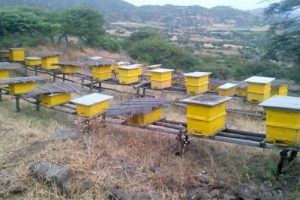
Land of origins, cradle of humanity which believed to contribute a dinner for the crucifying of Jesus, Ethiopia had traveled distant and known to be ancient civilization.
As to primary and secondary sources of history and concurrent tangible evidences, the country had passed through temptation though it has ample opportunity and blessing that can be exploited.
Unlike any other geographic entities on the living planet, Ethiopia possessed diverse climatic zones which are suitable for farming and herding.
Between the spatial variations ranging thousands of meters and some hundred meters above and below sea levels respectively, the land bears several types of plants and animals respective of the altitudinal difference.
Living the agronomy-the science of growing crops and managing soil aside for the time being, empirics tells that, such altitude diversity is home for millions of cattle, sheep, goats, dromedaries, poultry aquatic lives and other mane animals.
Nonetheless, the country has not yet utilized its potential from such lucrative sector due to circumstances. Apart from less productivity, there is also prevalence of illicit trade.
According to recent statement of Livestock Exporters’ Association, the sector has become inefficient due to contraband and illicit trade. The Ministry of Trade and Regional Integration, for its part, said it is working to address the problem. In due so the Ministry has started formulating policy pursuing lasting solution of the sector and resolve complications in relation to smugglers. Ethiopian Livestock Exporters Association President, Kibre Mulat told the Ethiopian Press Agency that the involvement of contrabands in livestock trade has greatly shrunk the volume of legal export trade this in turn causes the loss of staggering amount of income supposed to be obtained from the sector.
The country used to earn a lot of money by exporting cattle, sheep, goats, dromedaries to the oversea market; however, the president added that the revenue is now declining.
She exemplified that in 2016 Ethiopia was able to generate More than 147 million USD however since 2017 the value of the livestock trade remain to be below 67 million USD due to the expansion of illicit trade and smugglers.
The contraband trade doesn’t only affect the income but also has adverse impact on the quality of the product as livestock endure a long journey from departure to destination.
The impact of smuggling is not limited to the aforementioned facts, such an offence greatly cripple the need for foreign currency and taxation. Kibre further explicated that seldom legal traders hardly afford tax due to contraband trades.
Previously, there was interest for Ethiopia’s livestock in the Middle East, North and South Africa, Saudi Arabia. As this concurrent there is no much appetite for the product as animals suffer a long journey which has direct impact on the quality of product and productivity.
It was also stated that legal traders were reported to say they are unable to compete with the smugglers in terms of price. The Ethiopian Press Agency had moments with the Ministry of Trade and Regional Integration concerning the issue. The Ministry didn’t deny that smuggling has adverse impact on the livestock sector unveiling that the endeavor is incumbent upon other complications.
Desenet Belay, Skin and Hide Market Director at the Ministry said that his institution is devising policy and strategy, working in vigor and collaboration within actors to address the problem.
Despite efforts made to advance the livestock export trade and thereby secure foreign currency from the sector, the performance is declining from time to time.
Reluctance to form sound policy framework, lack of coordination among actors, failure to rate standards in price are some accelerating factors for the expansion of the illicit trade. Currently, statesmen have devised sound policy and submitted it to relevant authorities for ratification.
According to the director, the policy was devised based on preventive strategy so that it could reduce the illicit trade. The other problem frequently observed on the sector attributed to less execution capacity.
To alleviate this, a federal task force has been formed and began seizing contrabands on some border areas of the country. However, much due to the wide scope of the problem, all are determined to combat smuggling in collaboration with federal police, custom commission and other security forces.
Desenet finally said that since directives, price rate and systems have already been devised, a glimpse of hope has been observed over the preceding seven months. Documents tells Ethiopia has the largest livestock population in Africa, with 65 million cattle, 40 million sheep, 51 million goats, 8 million camels and 49 million chickens in 2020 (Central Statistics Agency, CSA, 2020a).
Between 2000 and 2016, the average stock of livestock, measured in Tropical Livestock Units (TLU) per 100 people, stood at 51 TLU, which is more than double the continental median of 23 TLU. The gross production value average growth rate during the same period was 4.5 percent — also twice the continental median of 2.2 percent (FAO, 2019).
The national herd supports, at least in part, the livelihoods of more than 11.3 million rural households, including 27– 35 percent of the highland livestock keepers, and a large proportion of the lowland herders, who live below the Government of Ethiopia established poverty line.
Livestock is a major source of animal protein, power for crop cultivation, means of transportation, export commodities, manure for farmland and household energy, security in times of crop failure, and means of wealth accumulation. The sector contributes up to 40 percent of agricultural Gross Domestic Product (GDP), nearly 20 percent of total GDP, and 20 percent of national foreign exchange earnings in 2017 (World Bank, 2017).
The intensive management system is practiced on market-oriented dairy and poultry farms in urban and peri-urban areas, where exotic breeds or crossbred animals are mainly kept for their high performance. In this system, milk production is market oriented and is predominantly from high yielding improved exotic breeds or crossbreeds with local cows. Intensive management involves relatively high inputs and technology.
The fluid milk produced is channeled to urban dwellers, restaurants and cafes, or milk processing plants. The main feeds available for urban dairying are crop residues, hay, and industrial by-products and some farms devote land to produce improved forage.
In most cases, free grazing is limited due to lack of land and thus, stall feeding is common. Shortages of feed and high feed prices, disease incidence, lack of land/space, shortage of genetically improved heifers for expansion, limited market outlets and seasonal fluctuation in demand for milk and meat are factors that limit the development of urban dairying in Ethiopia.
The mixed crop-livestock farming system is the dominant livestock production system in the Ethiopian highlands. In this system, crops and livestock play interdependent roles, with livestock providing draught power and manure for crop agriculture while crop residues provide feed for the livestock. In the mixed farming system, livestock follow crops as the means of livelihood.
BY LAKACHEW ATINAFU
THE ETHIOPIAN HERALD WEDNESDAY 30 MARCH 2022





